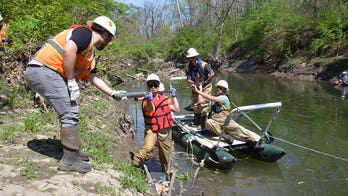Logging communities preparing for life after the dole
Dan Springer reports from Seattle, Washington
The government offices in Oregon’s Curry County are like scenes from a ghost town. Fliers are pasted to the windows. A meeting room is dark. The offices that are open have few, if any, residents getting services.
It's the result of diminishing federal welfare known as timber payments -- money given to counties with federal forest land in exchange for not letting loggers harvest trees.
"We can't rely on them for income and it's been declining every year," said Curry County Commissioner Susan Brown. "I feel like we have our hand out all the time."
She is among a group of lawmakers who think the payments are hurting the county in the long run. She wants the timber payments to end, even though it could bankrupt the county of 21,000, with an unemployment rate of 11.8 percent.
Last year, Congress appropriated $676 million, with Oregon taking the largest single share, $99 million.
The county is already running a bare-boned operation, which includes empty offices, a part-time building inspector and four sheriff deputies patrolling an area the size of Rhode Island.
Meanwhile, state lawmakers are proceeding as if Congress will not renew the payments, which began in 2000.
“What we’re becoming in the timber-dependent counties is the Appalachia of the Pacific Northwest,” said state Rep. Val Hoyle, leader of the Oregon’s Democrat-controlled House. “That’s not what we want to be.”
The legislature is considering several bills that would allow the state to create its own safety net for the rural timber counties.
One bill would have the state take over such county functions as elections, building code enforcement and taxation.
The most controversial would allow Democratic Gov. John Kitzhaber to declare a state of emergency, then impose a local tax to pay for public safety.
Matt Shelby, spokesman of the state’s Department of Administrative Services, said Oregon officials don’t know what will happen but are assuming a worst case scenario in which counties cannot provide basic services.
“We need to be in position to help our fellow Oregonians,” he said.
At least one lawmaker thinks the solution is more logging, not a state takeover.
“That’s not what we’re looking for,” said Republican state Rep. Bruce Hanna, who wants a federal forest policy that includes a “sustainable yield harvest.’”
Curry is typical of the many Oregon timber counties. Two-thirds of its land is owned by the federal government. And only 11 percent is privately owned and available to be developed.
Curry grew as the timber industry flourished. Lumber mills dotted the landscape and employed many hundreds of people. Now there is just a single mill still open.
The long slide began after the spotted owl was added in 1990 to the Endangered Species List. It prompted timber wars as protestors chained themselves to older trees.
Environmental laws were stiffened, adding layers of regulations and allowing multiple legal challenges to Bureau of Land Management timber sales.
The Clinton administration tried to fix the situation by crafting the 1994 Northwest Forest Plan. It called for reducing harvest levels to 25 percent of the peak in the 1980s. Roughly 51 million feet was set aside, but the total has never been hit because of legal challenges.





